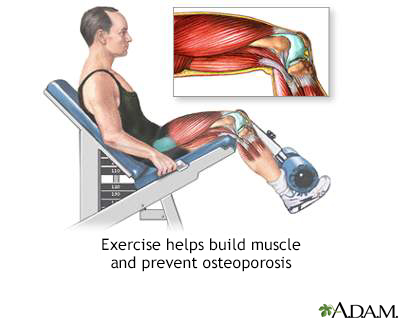Pregnancy SmartSiteTM
Age and exercise DefinitionIt is never too late to start exercising. Exercise has benefits at any age. Staying active will allow you to continue being independent and the lifestyle you enjoy. The right kinds of regular exercise can also reduce your risk of heart disease, diabetes, and falls. InformationYou don't need to spend hours in the gym every day to see benefits. Moving your body just 30 minutes a day is enough to improve your health. An effective exercise program needs to be fun and helps to keep you motivated. It helps to have a goal. Your goal might be to:
Your exercise program may also be a way for you to socialize. Taking exercise classes or exercising with a friend are both good ways to be social. You may have a hard time starting an exercise routine. Once you do start, though, you will begin to notice the benefits, including improved sleep and self-esteem. Exercise and physical activity can also:
Always talk to your health care provider before starting an exercise program. Your provider can suggest exercises and activities that are right for you. Exercises can be grouped into four main categories, although many exercises fit into more than one category: AEROBIC EXERCISE Aerobic exercise increases your breathing and heart rate. These exercises help your heart, lungs, and blood vessels. They may prevent or delay many diseases, such as diabetes, colon and breast cancers, and heart disease.
MUSCLE STRENGTH Improving your muscle strength can help you climb stairs, carry groceries, and stay independent. You can build muscle strength by:
BALANCE EXERCISES Balance exercises help prevent falls, which is a concern for older adults. Many exercises that strengthen the muscles in the legs, hips, and lower back will improve your balance. It is often best to learn balance exercises from a physical therapist before starting on your own. Balance exercises may include:
STRETCHING Stretching can help your body stay flexible. To stay limber:
ReferencesCenters for Disease Control and Prevention website. Physical Activity Basics. Physical activity for older adults: an overview. www.cdc.gov/physical-activity-basics/guidelines/older-adults.html. Updated December 22, 2023. Accessed June 25, 2024. Piercy KL, Troiano RP, Ballard RM, et al. The physical activity guidelines for Americans. JAMA. 2018;320(19):2020-2028. PMID 30418471 pubmed.ncbi.nlm.nih.gov/30418471/. Theou O, Rose DJ. Physical activity for successful aging. In: Fillit HM, Rockwood K, Young J, eds. Brocklehurst's Textbook of Geriatric Medicine and Gerontology. 8th ed. Philadelphia, PA: Elsevier; 2017:chap 99. | |
| |
Review Date: 4/27/2023 Reviewed By: Linda J. Vorvick, MD, Clinical Professor, Department of Family Medicine, UW Medicine, School of Medicine, University of Washington, Seattle, WA. Also reviewed by David C. Dugdale, MD, Medical Director, Brenda Conaway, Editorial Director, and the A.D.A.M. Editorial team. The information provided herein should not be used during any medical emergency or for the diagnosis or treatment of any medical condition. A licensed medical professional should be consulted for diagnosis and treatment of any and all medical conditions. Links to other sites are provided for information only -- they do not constitute endorsements of those other sites. No warranty of any kind, either expressed or implied, is made as to the accuracy, reliability, timeliness, or correctness of any translations made by a third-party service of the information provided herein into any other language. © 1997- A.D.A.M., a business unit of Ebix, Inc. Any duplication or distribution of the information contained herein is strictly prohibited. | |

 Benefit of regular...
Benefit of regular... Flexibility exerci...
Flexibility exerci... Exercise and age
Exercise and age Aging and exercise
Aging and exercise Weight lifting and...
Weight lifting and...
